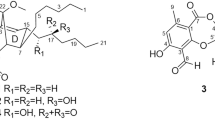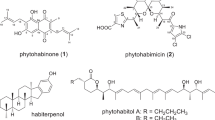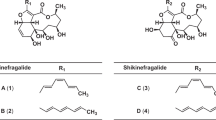Abstract
Talcarpones A (1) and B (2) are rare bisnaphthazarin derivatives produced by Talaromyces johnpittii (ex-type strain MST-FP2594), a newly discovered Australian fungus, which is formally described and named herein. The talcarpones were isolated along with the previously reported monomeric naphthoquinone, aureoquinone (3), suggesting a biosynthetic link between these metabolites. Talcarpone A is a lower homologue of hybocarpone (4), which was first isolated from a mycobiont of the lichen Lecanora hybocarpa. The structures of 1 and 2 were elucidated by detailed spectroscopic analysis, molecular modelling and comparison with literature data. Talcarpones 1 and 2 exhibited moderate antifungal activity (MIC 0.78–3.1 µg ml−1) and weak activity against Gram-positive bacteria (MIC 13–25 µg ml−1). The talcarpones also demonstrated noteworthy chemical reactivities, with 2 converting rapidly to 1, which in turn converted slowly to the highly coloured 3. These post-biosynthetic reactions point to a potential ecological role for the talcarpones in providing ongoing (slow-release) physicochemical protection for T. johnpittii against solar irradiation.
This is a preview of subscription content, access via your institution
Access options
Subscribe to this journal
Receive 12 print issues and online access
$259.00 per year
only $21.58 per issue
Buy this article
- Purchase on Springer Link
- Instant access to full article PDF
Prices may be subject to local taxes which are calculated during checkout





Similar content being viewed by others
References
Larsen TO, Smedsgaard J, Nielsen KF, Hansen ME, Frisvad JC. Phenotypic taxonomy and metabolite profiling in microbial drug discovery. Nat Prod Rep. 2005;22:672–95.
Iwai Y, Takahashi Y Selection of microbial sources of bioactive compounds. In: Ōmura S (ed). The Search for Bioactive Compounds from Microorganisms. Springer New York: New York, NY, 1992, pp 281–302.
Gilchrist CLM, Lacey HJ, Vuong D, Pitt JI, Lange L, Lacey E, et al. Comprehensive chemotaxonomic and genomic profiling of a biosynthetically talented Australian fungus, Aspergillus burnettii sp. nov. Fungal Genet Biol. 2020;143:103435.
Pitt JI, Lange L, Lacey AE, Vuong D, Midgley DJ, Greenfield P, et al. Aspergillus hancockii sp. nov., a biosynthetically talented fungus endemic to southeastern Australian soils. PLOS ONE. 2017;12:e0170254.
Lacey HJ, Vuong D, Pitt JI, Lacey E, Piggott AM. Kumbicins A-D: bis-indolyl benzenoids and benzoquinones from an Australian soil fungus, Aspergillus kumbius. Aust J Chem. 2016;69:152–60.
Roux I, Bowles S, Kalaitzis JA, Vuong D, Lacey E, Chooi Y-H, et al. Characterisation and heterologous biosynthesis of burnettiene A, a new polyene-decalin polyketide from Aspergillus burnettii. Org Biomol Chem. 2021;19:9506–13.
Li H, Shu S, Kalaitzis JA, Shang Z, Vuong D, Crombie A, et al. Genome mining of Aspergillus hancockii unearths cryptic polyketide hancockinone A featuring a prenylated 6/6/6/5 carbocyclic skeleton. Org Lett. 2021;23:8789–93.
Li H, Gilchrist CLM, Phan C-S, Lacey HJ, Vuong D, Moggach SA, et al. Biosynthesis of a new benzazepine alkaloid nanangelenin A from Aspergillus nanangensis involves an unusual L-kynurenine-incorporating NRPS catalyzing regioselective lactamization. J Am Chem Soc. 2020;142:7145–52.
Li H, Gilchrist CLM, Lacey HJ, Crombie A, Vuong D, Pitt JI, et al. Discovery and heterologous biosynthesis of the burnettramic acids: Rare PKS-NRPS-derived bolaamphiphilic pyrrolizidinediones from an Australian Fungus, Aspergillus burnettii. Org Lett. 2019;21:1287–91.
Berg A, Görls H, Dörfelt H, Walther G, Schlegel B, Gräfe U. Aureoquinone, a new protease inhibitor from Aureobasidium sp. J Antibiot. 2000;53:1293–5.
Stamatakis A. RAxML version 8: a tool for phylogenetic analysis and post-analysis of large phylogenies. Bioinformatics. 2014;30:1312–3.
Huelsenbeck JP, Ronquist F. MRBAYES: Bayesian inference of phylogenetic trees. Bioinformatics. 2001;17:754–5.
Lacey E, Tennant S. Secondary metabolites: The focus of biodiscovery and perhaps the key to unlocking new depths in taxonomy. Microbiol Aust. 2003;24:34–35.
Pitt JI, Hocking AD Fungi and Food Spoilage, 4th edn. Springer Nature: Switzerland, 2022.
Pitt JI The genus Penicillium and its teleomorphic states Eupenicillium and Talaromyces, 4th edn. Academic Press: London, 2022.
Doilom M, Guo J-W, Phookamsak R, Mortimer PE, Karunarathna SC, Dong W, et al. Screening of phosphate-solubilizing fungi from air and soil in Yunnan, China: four novel species in Aspergillus, Gongronella, Penicillium, and Talaromyces. Front Microbiol. 2020;11:585215.
Ernst-Russell MA, Elix JA, Chai CLL, Willis AC, Hamada N, Nash TH. Hybocarpone, a novel cytotoxic naphthazarin derivative from mycobiont cultures of the lichen Lecanora hybocarpa. Tetrahedron Lett. 1999;40:6321–4.
Nicolaou KC, Gray D. Total synthesis of hybocarpone. Angew Chem Int Ed. 2001;40:761–3.
Nicolaou KC, Gray DLF. Total synthesis of hybocarpone and analogues thereof. A facile dimerization of naphthazarins to pentacyclic systems. J Am Chem Soc. 2004;126:607–12.
Dragan SV, Pushilin MA, Glazunov VP, Denisenko VA, Anufriev VP. Total synthesis of hybocarpone, a cytotoxic naphthazarin derivative from the lichen Lecanora hybocarpa, and related compounds. Nat Prod Commun. 2014;9:1765–8.
Dragan SV, Borisova KL, Pelageev DN, Anufriev VP. Concerning the stereoselectivity of the oxidative dimerization of 3-alkyl-2-hydroxy-1,4-naphthoquinones in the synthesis of hybocarpone. Nat Prod Commun. 2019;14:1–5.
Huneck S, Ahti T. Lichen substances. Part 130. The chemistry of Cladonia boryi. Pharmazie. 1982;37:302.
Hamada N, Tanahashi T, Miyagawa H, Miyawaki H. Characteristics of secondary metabolites from isolated lichen mycobionts. Symbiosis. 2001;31:23–33.
Kokubun T, Shiu WKP, Gibbons S. Inhibitory activities of lichen-derived compounds against methicillin- and multidrug-resistant Staphylococcus aureus. Planta Med. 2007;73:176–9.
Kinoshita K, Usuniwa Y, Yamamoto Y, Koyama K, Takashashi K. Red pigments from the cultured mycobiont of a lichen, Sphaerophorus fragilis (L.) Pers. Lichenology. 2009;8:1–4.
Procházková E, Kucherak O, Stodůlková E, Tošner Z, Císařová I, Flieger M, et al. NMR structure elucidation of naphthoquinones from Quambalaria cyanescens. J Nat Prod. 2021;84:46–55.
Funa N, Funabashi M, Yoshimura E, Horinouchi S. A novel quinone-forming monooxygenase family involved in modification of aromatic polyketides. J Biol Chem. 2005;280:14514–23.
Elove GA, Schauble JH. NMR studies of intramolecular proton exchange in alkylated naphthazarins. Magn Reson Chem. 1987;25:194–200.
De la Vega JR, Busch JH, Schauble JH, Kunze KL, Haggert BE. Symmetry and tunneling in the intramolecular proton exchange in naphthazarin, methylnaphthazarin, and dimethylnaphthazarins. J Am Chem Soc. 1982;104:3295–9.
Moore RE, Scheuer PJ. Nuclear magnetic resonance spectra of substituted naphthoquinones. Influence of substituents on tautomerism, anisotropy, and stereochemistry in the naphthazarin system. J Org Chem. 1966;31:3272–83.
Timmers MA, Dias DA, Urban S. HPLC-NMR chemical profiling of the Australian carnivorous plant, Drosera erythrohiza subspecies magna. Nat Prod J. 2013;3:35–41.
Acknowledgements
Our sincerest gratitude to our friend and colleague Dr John I. Pitt (1937–2022) one of Australia’s greatest mycologists who wrote the books on food mycology that trained the world. Talaromyces johnpittii was collected by John, who recognised the strain’s novelty as a species of value to science. We thank Prof. Alison Rodger (MQ) for assistance with the acquisition of spectroscopic data. Molecular modelling was undertaken with the assistance of resources and services from the National Computational Infrastructure (NCI), supported by the Australian Government. This research was funded, in part, by the Australian Cooperative Research Centres Projects scheme (CRCPFIVE000119).
Author information
Authors and Affiliations
Corresponding author
Ethics declarations
Conflict of interest
The authors declare no competing interests.
Additional information
Publisher’s note Springer Nature remains neutral with regard to jurisdictional claims in published maps and institutional affiliations.
Supplementary information
Rights and permissions
Springer Nature or its licensor (e.g. a society or other partner) holds exclusive rights to this article under a publishing agreement with the author(s) or other rightsholder(s); author self-archiving of the accepted manuscript version of this article is solely governed by the terms of such publishing agreement and applicable law.
About this article
Cite this article
Lacey, A.E., Minns, S.A., Chen, R. et al. Talcarpones A and B: bisnaphthazarin-derived metabolites from the Australian fungus Talaromyces johnpittii sp. nov. MST-FP2594. J Antibiot 77, 147–155 (2024). https://doi.org/10.1038/s41429-023-00688-x
Received:
Revised:
Accepted:
Published:
Issue Date:
DOI: https://doi.org/10.1038/s41429-023-00688-x



